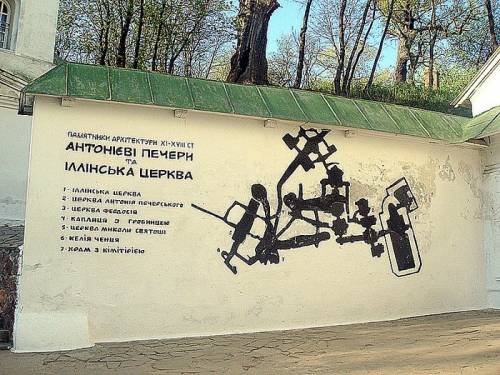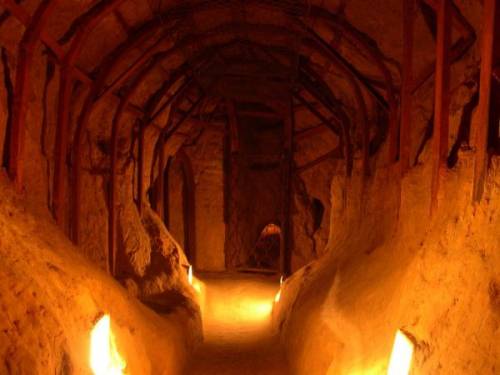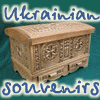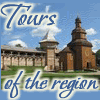 The Anthony caves of the Trinity Elijan monastery in Chernihiv - is a monument of underground religious architecture of the 11th -19th centuries.
The Anthony caves of the Trinity Elijan monastery in Chernihiv - is a monument of underground religious architecture of the 11th -19th centuries..
They were founded in 1069 as a Christian cave monastery by Prince Svaytoslav Yaroslavytch and by Antony Pechersky, a well known religious figure of Kievan Rus, a native of Lubetch and also the founder of Kiev’s Pecherskaya Lavra.
According to the chronicle, the monastery was originally named "Bogorodytsky" (the monastery of the Mother of God). The chronicle says that Anthony came to Chernihiv to escape the anger of Prince Izayslav. He liked the Boldyny hills very much and dug out a cave there. Ever since that time the monastery of the Mother of God has existed on the Boldyny hills. The establishment of the monastery was closely connected to the sharp rivalry between the two biggest cultural and political centers of the Rus state - Kiev and Chernihiv.
In Kiev, the Pechersky monastery had already acquired great fame by this time, and Chernihiv’s Prince Svaytoslav, anxious to challenge “the mother of Russian cities", with the help of Anthony created a monastery similar to the Pechersky in his own capital.
The intensive development of the cave monastery proceeded until 1239, when Chernihiv was devastated by the Tatar-Mongols. The construction of the stone Elijah's church near the caves’ entrance at the end of XI- early XII centuries is evidence of the importance of the caves prior to the Tatar invasion. Then came a period of decline that lasted until the XVI century. At that time restoration work was carried out in the monastery, and the sacristy of Elijah's church was built. There is no information about works inside the caves during this period.

Large-scale restoration of Elijah's monastery began in 1649. Chernihiv Colonel Stephan Podobaylo initiated the restoration, and it was caried out with his financing. Major changes took place from the end of XVIII century untill the end of XIX century. As a result of these reorganizations the Anthony caves have acquired their present form.
Today the Anthony caves is a complex of underground passages and chambers (the whole length is about 350 meters) located in the Boldyny hills within the modern city boundaries. The caves vary from 2 up to 12 meters below the surface, depending on the topography of the hills. All underground structures are located in two main levels. The geological nature of the Boldyny hills, loamy soil, allowed the builders to create underground chambers without any additional support and assured their durability. It explains the extent of the many galleries and chambers. Some walls in the caves still bear late medieval inscriptions - "graffitti".
Of particular interest in this respect is the lower level of the caves, which is reached from behind the east wall of the Feodosiy Totemsky church altar. This area (the whole length is more than 100 meters) has survived entirely as an earthen excavation, except for the three meters strengthened by bricks near the exit to the surface. It is evident this section was reorganized significantly, but the exact date and character оf these modifications remains to be established. The discovery of burials here indicates that this area of the complex served as an underground necropolis, and but it was also a residential area, as indicated by the excavation here of a monk’s cell.
Another ancient area of the Anthony caves is located on the upper circle of the complex. It includes earthen galleries and chambers between the churches of Feodosiy Totemsky and of Nikola Svaytosha and continues eastward from the latter. During archeological investigations in the caves, an ancient underground church of rather impressive sizes (length 12 m, width from 5 up to 2 meters, average height 3 meters) was found. The church has no artificial supports. It was abandoned in antiquity and never restored. South from this church, in the direction of the northern entrance to Elijah's church, there is a wide (up to three meters) gallery that may have been the main passage of the complex.

In XVIII - XIX centuries, most of the cave complex was modified in an effort to increase its size. Significant parts of the ancient construction were destroyed; and as a consequence it is now impossible to reconstruct the initial lay-out of the caves. During this period three caves enclosing brick churches were built. Of these three, the church of Feodosiy Totemsky (until 1795 the church of Mother of God Praise) is of the greatest architectural interest. The walls and vaults of the church are executed in Ukrainian baroque style (diverse niches, cornices, half-columns, arches, pilasters etc.).
The Feodosiy church interior is similar to the Trinity cathedral facade, which was the main church of the Trinity Eliya Monastery from the end of the 17th century. The fasade probably served as a model for the builders of the underground church. Feodosiy Totemsky church has become the main temple of the complex and is the biggest underground church in Left Bank Ukraine. Its dimensions are impressive: the highest point in the vestibule is 8, 5 meters, and its length is 16,5 meters. The church has a choir gallery arranged behind the dome brickwork in the northern part.
Two other underground churches - Anthony Pechersky (length 11,7 m. width 4 m, height 4,5 m in vestibule) - the first beyond the entrance, and Nikola Svyatosha church (length 12 m, biggest width 2,32 m, height 2,68 m) are of more modest dimensions.
High humidity in the caves made it impossible to install wooden iconostasis here. Their role in the underground temples was taken by brick walls with metal icons on them. The Holy Doors,also made of metal,are still preserved in the Anthony and Feodosiy churches. The church authorities used the caves for religious propagation, and for this purpose two "relics" were arranged here: the cell of Anthony Pechersky and a tomb with bones of monks killed in 1239 by the Mongol-Tatars.
High humidity prevented from building wooden iconostases. They were replaced by walls of bricks with metal icons on them. Holy gates were also made of metal (preserved in St. Anthony and St. Theodosiy churches). Traditionally the cell of Anthony Pechers’kyi and the tomb of monks killed in 1239 by Mongol-Tartars are considered to be the sacred places.
In 1967 the monument was included as a part of Chernihiv architectural-historical park.




























